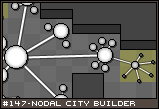| Three Hundred |
| - Index Page |
| - About... |
| - By Year |
| Collections |
| - Comp-Grid |
| - Procedural |
| - Tactics |
| - Tiny Crawl |
| - Misc |
| Previous | Mechanic #147 | Next |
![[nodal1.png]](set08/img/entry147-nodal1.png)
This entry is going to assume a basic real time strategy game, but rather than building the structures on the map's grid directly, it is instead built out of a series of circular nodes - similar to the game Moonbase Commander. But, whereas Moonbase Commander was more like Artillery mixed with Tower Defense, this idea is a more gameplay agnostic concept that allows careful and deliberate placement of nodes.
![[nodal2.png]](set08/img/entry147-nodal2.png)
The premise behind the entire thing is the pie wedge. Put simply, each node you wish to build will come with an associated pie wedge that you can use to connect it to a larger node. This wedge will decide the placement of the sub-node, along with the slope of the edge connecting it. Once placed, you simply drag the node from the base to decide how far away to build the node. All connections take up a pie wedge, so even newly created nodes already have at least some part of the pie already claimed.
![[nodal3.png]](set08/img/entry147-nodal3.png)
The wedges are different sizes, so they will define how many sub-nodes you can build. Wedges do not need to be built right next to each other - you can leave space between wedges, though if you do not leave enough space, you will not be able to build additional nodes. The wedges are defined for a specific sized node, so if you have a medium-sized wedge, you may only build off of medium-sized nodes. Some nodes exist for no other reason than to convert between sizes. For instance, a medium node with a large wedge will act as a bridge between medium and large nodes.
![[nodal4.png]](set08/img/entry147-nodal4.png)
Some nodes can be inserted between two other nodes on the edge that connects them. These nodes have two pie wedges already claimed on them, with a broken edge extending from them. They can be inserted on an edge, allowing additional building to be performed off it.
![[nodal5.png]](set08/img/entry147-nodal5.png)
The lightly colored squares on the map are resources. In order to harvest these resources, you simply build resource gathering nodes on top of them. The mode gathering nodes you can fit in the resource zone, the more quickly you collect resources.
|
